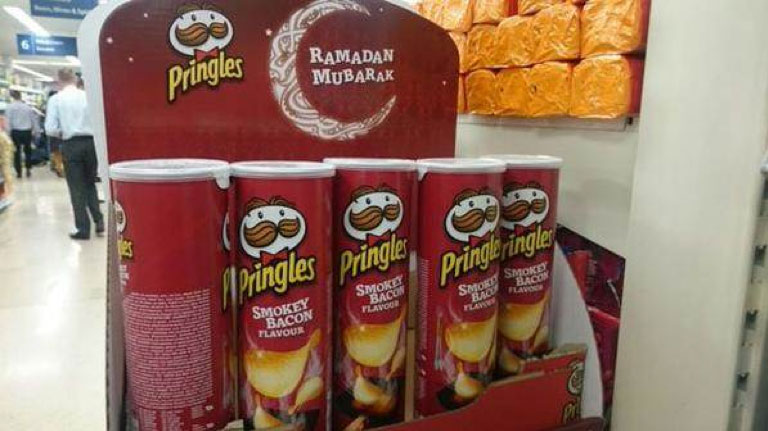Estimated reading time: 12 minutes
What Does Brand Communication Mean to You?
Effective brand management, brand strategy and brand communication are indispensable components when building a bond between your company and your customers.
Each brand and therefore each audience it appeals to is different from the next. Communication that is not well-defined, accurate and relevant can alienate, offend or worst of all bore the hell out of people.
The aim of your brand communication in particular is to provide your company with a voice. This voice should not only be on-point when it comes to the messaging it delivers but should also humanise the company as a whole.
Don’t Be That Guy
With that being said, how “human” do you think your company is going to look if you drop the ball by offering bacon-flavoured potato chips as an ideal snack during a Ramadan feast?
Maybe human enough to be the uncle everyone dreads showing up over the festive period, spouting his archaic, borderline racist slurs. That’s not exactly the look you were going for as a company though, we can be sure of that.

This faux pas is attributed to Tesco and a cobbled-together display and not to Pringles themselves.
This one example highlights the very real danger that a slight oversight, minor ignorance or failure to carry out due diligence can lead to the most unwanted type of media exposure (this image was, only naturally, shared across the Twitterverse with remarkable swiftness, forcing Tesco to promptly remove the display and issue an apology).
Bear in mind that this was a blunder made by a British company inside its own country!
There was no cross-border campaign in place here. This is not a lack of knowledge about a very specific cultural tradition which caused offence. Nor was it a word simply translated to mean something unexpectedly ambiguous in a different language.
This was, in fact, found at a Tesco store just down the road from one of Europe’s largest Muslim places of worship, Whitechapel’s East London Mosque.
When you consider that Islam is the “second largest religion in the United Kingdom,” with 4.4% of the population (some 2.8m people) identifying as Muslim, you would think at least someone, anyone, working at the store would have known better.
All of this – and it’s just one among a litany of examples we could have included – adds up to a stark warning of the dangers you face when promoting your company’s brand, image or products across different cultures and demographics.

Global Villages and Shrinking Worlds
Developments in technology have brought improvements to communication and transportation that have led to a shrinking of the world. In both personal and business settings, far-away places are (almost literally given touchscreen phones) at your fingertips.
That means there are incredible business opportunities available to global brands who are prepared to use these tools to spread their message into different countries and cultures.
However, it’s one thing to identify the opportunity offered by this remarkably wide audience of customers, and something else entirely to navigate the tangled and complex diversity of cultures, beliefs and practices you’re bound to encounter along the way.
That’s without even mentioning other permutations such as spending capacity, consumer patterns, product needs or the impact of unpredictable events on consumer attitudes.
All of this varies greatly from country to country and culture to culture. The considerations are seemingly endless.
With a rise in the globalisation of business markets in several sectors the importance of understanding a diverse range of cultures is amplified tremendously.
Nowadays a sure-fire way to alienate huge swathes of potential customers is to simply ignore any cultural differences and not bother with research into cultural diversity whatsoever.
The Pitfalls of a “Glocal” Approach
When choosing to expand into a new part of the world, there are two major hazards you could fall victim to:
- Failure to do your due diligence on a country-specific (or culture-specific) campaign.
This could, of course, lead to it being unintentionally offensive due to clashes of culture, translation oversights and so on. - Using a single campaign in several countries and cultures and hoping for the best.
This makes no allowances for any potential ambiguity or confusion, doesn’t take into consideration that it might be offensive and ignores any translation issues with product names, taglines etc.
That doesn’t just apply to those of us making our first tentative moves into global branding, however, because it’s simply startling how often the big brands and worldwide companies fall short when getting their multinational advertising messages wrong.
But Mickey Mouse Doesn’t Speak French!
We need look no further than the 2018 campaign run by Dolce & Gabbana in China, which was widely criticised for being sexist and racist, sending the brand to an all-time low in that part of the world.
The ads in question – which mocked the use of chopsticks (no, seriously, they did that) – led to a removal of products, a cancelled fashion show and an apology video. None of which helped undo any of the damage caused in the immediate aftermath of such an ill-conceived idea.
Not to mention the fact that the financial ramifications were obviously huge.
Even the almighty House of Mouse can run into issues when moving into new territory.
Perhaps it could be argued that during their expansion into Europe with Euro Disney, they were following a classic branding rule of maintaining market-wide consistency. That didn’t stop the theme park from initially being a lot less successful than they’d hoped.
By blindly implementing the tried-and-tested formula that worked so well in the States, Disney completely failed to adapt the brand to the localised clientele.

A stand-out example are the English-only instructions used in a park situated in the middle of France!
Can you imagine building a theme park and not bothering to throw up any signs in the local language of the country; just so you could stick to your marketing plan?
Luckily, they stopped short of swapping the Parisian’s breakfast croissants with hamburgers and super-duper XXXL fries, but rumour has it that this was next on the list.
When they did eventually factor in cultural variations and catered more to the needs of the consumers in the actual country they were in, rather than the country they were from, success was quick to follow.
Quelle surprise!
Should Glocalisation Have You Running Scared?
In a word: no.
In two, more emphatic, words: Absolutely not!
The trick is to approach any outreach that falls outside your current comfort zone (whether you have that level of comfort because of your experience in the sector, research and due diligence, or a combination of both) with the correct due care and attention.
As blindingly obvious as it may seem, that’s actually worth stating again:
If you want to expand into a different part of the world, do some research first.
Promoting your brand/product for the first time in your very own country and in your own native language comes with enough obstacles as it is; obstacles you will have, no doubt, identified by doing some research or applying your experience.
If it’s a new part of the world you’re moving in to however, experience doesn’t come into it; you haven’t got any.
So that leaves only research.
If you’re not going to bother with any research, you’re basically making the assumption that providing you keep the messaging and positioning identical, your brand/product will be perceived exactly the same way in different countries and cultures. Such an assumption smacks of laziness, arrogance, or perhaps both.
Yes, it’s true that some products function in the same way regardless of the country you use them in – but we’re talking the TVs, mobile phones and laptops of the world.
What if your product is very culturally specific, even if it doesn’t appear so at first?
Rice or Rice Crispies for Breakfast
“Breakfast?” you say. “Why, everyone eats food, or at least has a drink, upon waking up.
Breakfast is not specific to culture.”
On the face of it breakfast does indeed appear to be multicultural. Dig a little deeper, however, by looking at breakfast cereal – a great staple of many a westerner’s diet – and all of a sudden you may struggle to cross borders.
This is the very problem that Weetabix faced when it begun to explore opportunities in, of all places, Kenya.
In the UK, the breakfast cereal market is fiercely competitive and Weetabix, one of the most common household brands, enjoys a 7% share. Contrast that with the 70% share of cereal sales it enjoys in Kenya!
Granted, Weetabix has (to a certain extent) exploited a market that others have been reluctant to explore properly. Though that alone is a lesson in identifying opportunities in a globalised market-place.
Special mention must also be made of the efforts they took and the subsequent cultural awareness they gained. By using this knowledge, they were able to create a strategy that made them an unlikely success.
The Weetabix sales-force teams in Kenya, powered by bicycle and carrying with them sachets containing just two biscuits, make multiple stops at small shops. Here, small-value but regular transactions are made, which appeal to the local customers and allow Weetabix to develop a consistent output.
Weetabix could have simply persevered with sales of larger boxes (as is the norm in the UK) without doing any research about cultural tendencies in the areas they chose. Had they done so, they would have likely failed to gain traction when these ‘bulk’ offerings didn’t appeal to the locals – and left with their tail between their legs.
Compare that to the strategy Weetabix employed in Mexico, where large boxes containing 48 biscuits are the most popular among consumers (it seems Mexico is a BIG fan of wholegrain breakfast cereal!) and you have a fantastic example of a company who have taken the time and resources to learn about local cultures and different buying trends. They then applied that knowledge to be successful in numerous parts of the world.
We Don’t Need No Education… Er, On Second Thoughts
That’s not to say consumer patterns and spending capacity are the be-all and end-all of cultural differences; far from it in fact.
What if Weetabix translated to ‘cement,’ for example, and nobody bothered to check? Or perhaps ‘doggy’, giving the packages containing two Weetabix biscuits a completely different image. In those circumstances, packet sizes of two biscuits or 22 wouldn’t have made the least bit of difference, if the customers thought they were being sold dog food for breakfast.
Changing a product, even just the product’s name or tagline, to suit local preferences can open up the possibility of devaluing the brand, or at the least, removing some of the elements that make the product recognisable and appealing in the first place.
In such circumstances, the company may be better off finding existing markets that already suit the product and remain as faithful to the tried-and-tested formula as possible. Even though we’ve already seen with the Euro Disney example above that it’s not always a successful approach, it cannot be dismissed out of hand.
However, this misses the point somewhat.
Whether you’re planning to adapt your product or your messaging to suit your new target audience, or if you’re more comfortable with the idea of using the existing formula and applying it to an already established, suitable marketplace, the fundamentals come down to the amount of research and due diligence you do prior to launching a campaign.
Introducing an unfamiliar product to a new country will inevitably involve an element of education. If consumers don’t appreciate the nuances of the product or understand the benefits it could bring to their lives, they’re not likely to change their pre-existing patterns to take the chance on something new and untested.

Likewise, if there’s an existing marketplace you think is suitable enough to launch your campaign as is, you’d have to assume people are already buying an alternative version (because, let’s face it, truly disruptive products and services are few and far-between).
In such a scenario, there’s a host of benefits to be gained in studying your competitors’ approach. Have they changed their messaging or taglines for this country? Is there an obvious omission from one country’s campaign to another? Are they doing something out of the ordinary or noteworthy that they don’t do anywhere else?
As a side note, taking for granted the effects an established brand has upon preconceptions would be unwise. If a brand is well-known enough, even in a new marketplace, for your competitors to skip the need for education entirely, then taking inspiration or ideas from their approach could be risky.
Where a brand is not established, however, meaning no presuppositions exist about what the company is likely to deliver, then failure to educate could be a critical blow that your company, at least in that part of the world, doesn’t recover from.
Conclusion
By now, it should be evident that it’s very possible, if not probable, that a brand’s efforts to maintain identical positioning will not prevent it from being perceived undesirably in different countries and cultures.
Therefore it’s highly recommended that those in charge of multinational and/or cross-cultural campaigns factor in the relevant due diligence process when preparing their international marketing plans.
This should involve the study of each individual culture and the creation of tailored strategies for each one. To begin with, this will mean research into trademark availability. We would recommend you cover all bases, however, to avoid leaving yourself exposed to potentially expensive consequences. Linguistic and cultural screening of brand names, taglines and logos should be part of any due diligence process to improve your chances of success.
Ultimately, being able to demonstrate knowledge and understanding of your audience will give consumers a better chance of interpreting your company in an anticipated, even advantageous way, which will in turn maximise the chances of your success.
If you’re a campaign manager, brand leader or are considering taking your brand or products to a new market, easybrandcheck help you avoid all the pitfalls. Get in touch to find out more.
